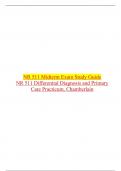Exam (elaborations)
NR 511 Midterm Study Guide (Version 2), NR 511 Differential Diagnosis and Primary Care Practicum, Chamberlain.
- Course
- Institution
NR 511 Midterm Study Guide (Version 2), NR 511 Differential Diagnosis and Primary Care Practicum, Chamberlain.
[Show more]



